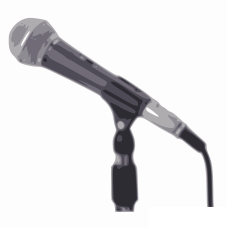The diaphragm of a condenser microphone is the movable plate of a capacitor. WHen properly polarized the vibration of the diaphragm in relation to the back plate produces an ac audio-output voltage. The condenser capsule has a capacitance of 10 to 60 pF; thus, you should connect it to an impedance converter with extremely high input impedance for a flat frequency response. The conventional impedance converter is a JFET source follower with an additional amplifying and power-decoupling circuit.
The balanced audio pair at the XLR connector’s pins 2 and 3 both carry both power (phantom power) and audio signal. Typically the amplifying/decoupling circuit contains an audio transformer or a couple of capacitors to separate the dc power from the audio signal.
High-value dc-blocking capacitors can generate measurable and audible distortion. Audio signal transformers have also their limitations. The circuit shown at Condenser microphone uses dc-coupled impedance converter article eliminates transformers and coupling capacitors using self-balancing microphone interface circuit.
This is an interesting circuit idea to look at. I have not tried this in practice, but looks interesting.

7 Comments
lurlempObbery says:
There is noticeably a bundle to know about this. I assume you created specific nice points in functions also.
Tomi Engdahl says:
Link update:
Condenser microphone uses dc-coupled impedance converter
https://www.edn.com/design/analog/4369073/Condenser-microphone-uses-dc-coupled-impedance-converter
Tomi Engdahl says:
Very simple amplifier with phantom power
https://www.edn.com/very-simple-amplifier-with-phantom-power/
Tomi Engdahl says:
Condenser microphone uses dc-coupled impedance converter
https://www.edn.com/condenser-microphone-uses-dc-coupled-impedance-converter/
Tomi Engdahl says:
Typically around 200Ω or less. Impedance of the transducer itself is very high – many MΩ. Can be as good as 20 Hz to 20kHz or better. High quality sound recording, some sound support systems where additional sensitivity is needed.
Condenser Microphone: Capacitor Microphone
The condenser microphone or capacitor microphone is able to provide high quality audio.
https://www.electronics-notes.com/articles/audio-video/microphones/condenser-capacitor-microphone.php
As the name implies, the condenser microphone or capacitor microphone uses a capacitance that varies in line with the incoming signal to generate the varying output voltage.
The name condenser microphone still persists. The microphone was invented in the days when capacitors were still called condensers.
Tomi Engdahl says:
https://mxlmics.com/how-condenser-microphones-work/
Tomi Engdahl says:
What Are Microphone Transformers And What Is Their Role?
https://mynewmicrophone.com/what-are-microphone-transformers-and-what-is-their-role/
Some microphones have transformer-coupled outputs, while others are deemed transformerless. Some microphones even have transformers in the middle of their signal chains rather than at their outputs.
What is a microphone transformer? A mic transformer is a passive electrical device that physically isolates two circuits while maintaining an electrical relationship between the circuits. Mic transformers have two conductive coils (one for each circuit) wound around a common magnetic core. They adjust voltage, current, and impedance.
In this article, we’ll discuss the role of the transformer in microphones as well as the microphones that use transformers and those that do not.